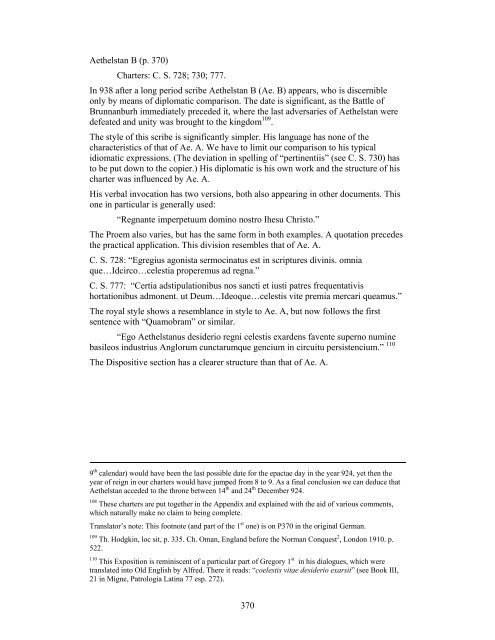Provisional Drogereit pdf
Provisional Drogereit pdf
Provisional Drogereit pdf
You also want an ePaper? Increase the reach of your titles
YUMPU automatically turns print PDFs into web optimized ePapers that Google loves.
Aethelstan B (p. 370)<br />
Charters: C. S. 728; 730; 777.<br />
In 938 after a long period scribe Aethelstan B (Ae. B) appears, who is discernible<br />
only by means of diplomatic comparison. The date is significant, as the Battle of<br />
Brunnanburh immediately preceded it, where the last adversaries of Aethelstan were<br />
defeated and unity was brought to the kingdom 109 .<br />
The style of this scribe is significantly simpler. His language has none of the<br />
characteristics of that of Ae. A. We have to limit our comparison to his typical<br />
idiomatic expressions. (The deviation in spelling of “pertinentiis” (see C. S. 730) has<br />
to be put down to the copier.) His diplomatic is his own work and the structure of his<br />
charter was influenced by Ae. A.<br />
His verbal invocation has two versions, both also appearing in other documents. This<br />
one in particular is generally used:<br />
“Regnante imperpetuum domino nostro Ihesu Christo.”<br />
The Proem also varies, but has the same form in both examples. A quotation precedes<br />
the practical application. This division resembles that of Ae. A.<br />
C. S. 728: “Egregius agonista sermocinatus est in scriptures divinis. omnia<br />
que…Idcirco…celestia properemus ad regna.”<br />
C. S. 777: “Certia adstipulationibus nos sancti et iusti patres frequentativis<br />
hortationibus admonent. ut Deum…Ideoque…celestis vite premia mercari queamus.”<br />
The royal style shows a resemblance in style to Ae. A, but now follows the first<br />
sentence with “Quamobram” or similar.<br />
“Ego Aethelstanus desiderio regni celestis exardens favente superno numine<br />
basileos industrius Anglorum cunctarumque gencium in circuitu persistencium.” 110<br />
The Dispositive section has a clearer structure than that of Ae. A.<br />
9 th calendar) would have been the last possible date for the epactae day in the year 924, yet then the<br />
year of reign in our charters would have jumped from 8 to 9. As a final conclusion we can deduce that<br />
Aethelstan acceded to the throne between 14 th and 24 th December 924.<br />
108<br />
These charters are put together in the Appendix and explained with the aid of various comments,<br />
which naturally make no claim to being complete.<br />
Translator’s note: This footnote (and part of the 1 st one) is on P370 in the original German.<br />
109 2<br />
Th. Hodgkin, loc sit, p. 335. Ch. Oman, England before the Norman Conquest , London 1910. p.<br />
522.<br />
110 This Exposition is reminiscent of a particular part of Gregory 1 st in his dialogues, which were<br />
translated into Old English by Alfred. There it reads: “coelestis vitae desiderio exarsit” (see Book III,<br />
21 in Migne, Patrologia Latina 77 esp. 272).<br />
370
















